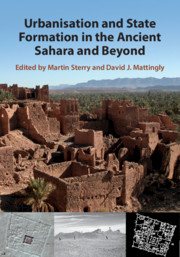Book contents
- Urbanisation and State Formation in the Ancient Sahara and Beyond
- The Trans-saharan Archaeology Series
- Urbanisation and State Formation in the Ancient Sahara and Beyond
- Copyright page
- Contents
- Figures
- Tables
- Contributors
- Preface
- Part I Introduction
- Part II Oasis Origins in the Sahara: A Region-by-Region Survey
- Part III Neighbours and Comparanda
- 9 Early States and Urban Forms in the Middle Nile
- 10 Mediterranean Urbanisation in North Africa
- 11 Numidian State Formation in the Tunisian High Tell
- 12 The Origins of Urbanisation and Structured Political Power in Morocco
- 13 Architecture and Settlement Growth on the Southern Edge of the Sahara
- 14 Long-Distance Exchange and Urban Trajectories in the First Millennium AD
- 15 First Millennia BC/AD Fortified Settlements at Lake Chad
- 16 At the Dawn of Sijilmasa
- 17 The Early Islamic Trans-Saharan Market Towns of West Africa
- 18 Urbanisation, Inequality and Political Authority in the Sahara
- Part IV Concluding Discussion
- Index
- References
11 - Numidian State Formation in the Tunisian High Tell
from Part III - Neighbours and Comparanda
Published online by Cambridge University Press: 23 March 2020
- Urbanisation and State Formation in the Ancient Sahara and Beyond
- The Trans-saharan Archaeology Series
- Urbanisation and State Formation in the Ancient Sahara and Beyond
- Copyright page
- Contents
- Figures
- Tables
- Contributors
- Preface
- Part I Introduction
- Part II Oasis Origins in the Sahara: A Region-by-Region Survey
- Part III Neighbours and Comparanda
- 9 Early States and Urban Forms in the Middle Nile
- 10 Mediterranean Urbanisation in North Africa
- 11 Numidian State Formation in the Tunisian High Tell
- 12 The Origins of Urbanisation and Structured Political Power in Morocco
- 13 Architecture and Settlement Growth on the Southern Edge of the Sahara
- 14 Long-Distance Exchange and Urban Trajectories in the First Millennium AD
- 15 First Millennia BC/AD Fortified Settlements at Lake Chad
- 16 At the Dawn of Sijilmasa
- 17 The Early Islamic Trans-Saharan Market Towns of West Africa
- 18 Urbanisation, Inequality and Political Authority in the Sahara
- Part IV Concluding Discussion
- Index
- References
Summary
For many archaeologists this quote from Godelier encapsulates one of the main goals of our discipline. The formation of states and cities (one of the elements normally accompanying this form of societal organisation) cannot therefore be limited to the study of individual cases. Whatever the specific differences, these cases may, when interpreted under the light of well-founded hypothetical models, constitute a fundamental part in understanding the intercultural processes in the creation of new hierarchies. However, there is not widespread agreement on how this may take place. For some of our colleagues, the notion of ‘state’ (and perhaps the notion of ‘city’ as well?) is just a ‘Western’ construction, which does not have any significance in many other parts of the world. According to this constructivist point of view, the state simply did not exist in these areas.
- Type
- Chapter
- Information
- Publisher: Cambridge University PressPrint publication year: 2020
References
- 3
- Cited by

